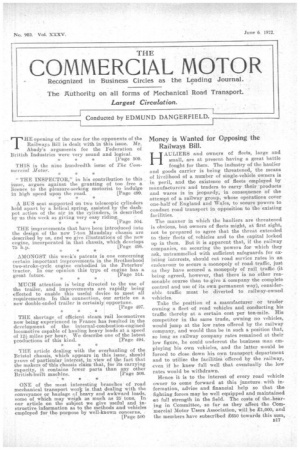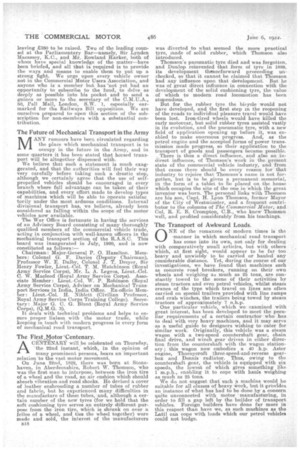Money is Wanted for Opposing the Railways Bill.
Page 1

Page 2

If you've noticed an error in this article please click here to report it so we can fix it.
HAULIERS and owners of fleets, large and small, are at present having a great battle fought for them. The industry of the haulier and goods carrier is being threatened, the means of livelihood of a number of single-vehicle owners is in peril, and the existence of fleets employed by ma,nufaciurers and traders to carry their products and wares is in jeopardy, in consequence of the attempt of a railway group, whose operations cover one-half of England and Wales, to secure powers to conduct road transport in opposition to the existing facilities. _ .
The manner in which the hauliers are threatened is obvious, but owners of fleets might, at first sight, not be prepared to agree that the threat extended to their fleets of, vehicles and to the capital locked up in them. But it is apparent that, if the railway companies, on securing the powers for which they ask, untrammelled with sufficient safeguards for existing interests, should cut road service rates in an endeavour to secure a monopoly of road traffic, just as they have secured a monopoly of rail traffic (it being agreed, however, that there is no other reasonable course than to give a; company the complete control and use of its own permanent way), considerable traffic must be diverted to railway-owned vehicles.
Take the position of a manufacturer or trader owning a fleet of road vehicles and conducting his traffic thereby at a certain cost per ton-mile. His competitor in the same trade, owning no vehicles, would jump at the low rates offered by the railway company, and would thus be in such a position that, so long as railway company rates remained at their low figure, he could undercut the business man employing his own vehicles, and the latter would be forced to close down his own transport department and to utilize the facilities 'offered by the railway, even if he knew full well that eventually the low rates would be withdrawn.
Hence it is to the interest of every road vehicle owner to come forward at this juncture with information, advice and financial help so that the fighting forces may be well equipped and maintained a t full strength in the field. The costs of the.hearing in Committee, so far as they affect the Commercial Motor Users Association, will be 21,000, and the members have subscribed £650 towards this sum, leaving £350 to be raised. Two of the leading coimsel at the Parliamentary Bar—namely, Sir .J..emden Macassey, K.C., and Mr. Rowland Harker, both of whom have special knowledge of the matter—have been briefed, and all that is required is to provide the ways and means to enable them to put up a strong fight. We urge upon every vehicle owner not in the Commercial Motor Users Association, andanyone who is a member but has not yet had an opportunity to subscribe to the fund, to delve as deeply as possible into his pocket and to send a guinea or more to the secretary of the C.M.U.A., 50, Pall Mall, London, S.W. I, especially _ earmarked for the Railways Bill opposition. We are ourselves prepared to open this section of the subscription for non-members with I substantial contribution.
The Future of Mechanical Transport in the Army MANY rumours have been circulated regarding the place which mechanical transport is to occupy in the future in the Army, and in some quarters it has been stated that horsed transport Will be altogether dispensed with. We believe that such a statement is much exaggerated, and that the authorities will feel their way very carefully before taking such a drastic step, although we certainly agree that the use of selfpropelled vehicles should be encouraged in every branch where full advantage can he taken of their capabilities, and every effort made to develop types of machines which will be able to operate satisfac torilzunder the most arduous conditions. Internal divisional transport has, we believe, already been considered as falling within the scope of the motor vehicles now available.
The War Office is fortunate in having the services of an Advisory Board consisting of many thoroughly qualified, members of the commercial vehicle trade, acting in conjunction with well-known officers in the mechanical transport section of the R.A.S.C. This board was inaugurated in July, 1920, and is now constituted as follows:—
Chairman: Major-General P. 0. Hazeiton. Members: Colonel G. F. Davies (Deputy Chairman), Professor W. E. Dalby, Colonel ..1`. T. Dreyer, Sir Henry Fowler, Lieut.-Col. T. M. Hutchinson (Royal Army Service Corps), Mr. L. A. Legros, Lieut.-Col. C. W. Macleod (Royal Army Service Corps). Associate Member : Lieut.-Col. 'W. P. Robinson (Royal Army Service Corps), Adviser on Mechanical Transport Services in India, India Office. Ex-officio Member : Lieut.-Col. H. Niblett (Civilian Professor, Royal Army Service Corps Training College). Seemtary : Major G. C. G. Blunt (Royal Army Service Corps), (Q.M.G. 3). It deals with technical problems and helps to ensure proper liaison with the motor trade, while keeping in touch with modern progress in every form of mechanical road transport.
The First,,Motor 'Centenary.
ACENTENARY will be celebrated on Thursday, the 22nd instant, which, in the opinion of many prominent persons, bears an important relation to the vast motor movement.
On June 22nd, 1822, there was born at Stonehaven, in Aberdeenshire, Robert W. Thomson, who was the first man to interpose, between the iron tire of a wheel and the road, an air cushion which should absorb vibration and road shocks. He devised a cover of leather enshrouding a number of tubes of rubber and fabric, but he experienced many difficulties in the manufacture of these tubes, and, although a certain number of the new tyres (for we hold that the soft cushioning tyre serves an entirely different purpose from the iron tire, which is shrunk on over a felloe of a wheel, and ties the wheel together) were made and sold, the interest of the manufacturers alS was diverted to what seemed the more practical tyre, made of solid rubber, which Thomson also introduced.
Thomson's pneumatic tyre died and was forgotten, and Dunlop reinvented that _form of tyre in 1889, its development thenceforward proceeding unchecked, so that it cannot be claimed that Thomson had any influence upon that deteloprnertt. But he was of great direct influence in connection with the development of the solid cushioning tyre, the value of which to modern road locomotion has been stupendous.
But for the rubber tyre the bieyele would not have developed, and the first step in the reopening of the roads to individual pleasure travel would have been lost. Iron-tired wheels would have killed the early motorcar, but solid rubber tyres assisted vastly in its evolution, and the pneumatic tyre, with a new field of application opening up before it, was enabled to snake enormous progress. And, as the petrol engine and the accepted forms of power transmission made progress, so their application to the transport of goods and passengers became possible.
There is thus a direct influence, and also an indirect influence, of Thomson's work in the present state of the commercial vehicle industry, and from that cause there should be every reason for that industry to rejoice that Thoinson's name is not forgotten, but is to be given a permanent memorial, in the form of a tablet to Be placed on the house which occupies the site of the one in which the great inventor was born. The .personal links with Thomson are his son, Capt. H. Lyon Thomson, former Mayor of the City of Westminster, and a frequent contributor to the columns of The Commercial Motor, and Col. R. E. B. Crompton, C.B., who knew Thomson well, and profited considerably from his teachings.
The Transport of Awkward Loads.
ONE of the romances of modern times is the 'manner in which mechanical road transport has come into its own, not only for dealing with comparatively small articles, but with others which, at first sight, would appear to be far too heavy and unwieldy to be carried or hauled any considerable distance. Yet, during the course of our investigations, we have found that machines such as concrete road breakers, running on their own wheels and. weighing as much as 25 tons, are constantly towed to the scene of their activities by steam tractors and even petrol vehicles, whilst steam cranes of the type which travel on lines are often carried on special trailers provided with line ramps and crab winches, the trailers being towed by steam tractors of approximately 7 n.h.p.
One particular vehicle, which we examined with great interest, has been developed to meet the peculiar requirements of a certain contractor who has to deal with very heavy machines, and it may serve as a useful guide to designers wishing to cater for similar work. Originally, this vehicle was a steam wagon with a two-speed countershaft gear, chain final drive, and winch gear driven in either direction from the countershaft with the wagon stationary; this wagon now embodies a 40 .h.p. Aster engine, Thornyeroft three-speed-and-reverse gearbox and Dennis radiator. Thus, owing to the countershaft gear, the vehicle is equipped with six speeds, the lowest of which gives something. like 1 m.p.h., enabling it to cope with hauls weighing as much as 25 tons.
We do not suggest that such It machine would be suitable for all classes of heavy work, hut it prbvides an instance of what has had to be done by a concern quite unconnected with motor -manufacturing, in order to fill a gap left by the builder of transport vehicles. Foreign builders have &me far more in this reipect than have we, as such machines as the Latil can cope with loads which our petrol vehicles could not budge.






























